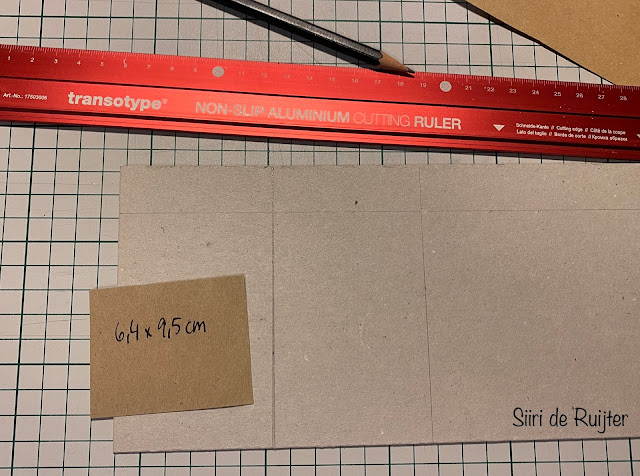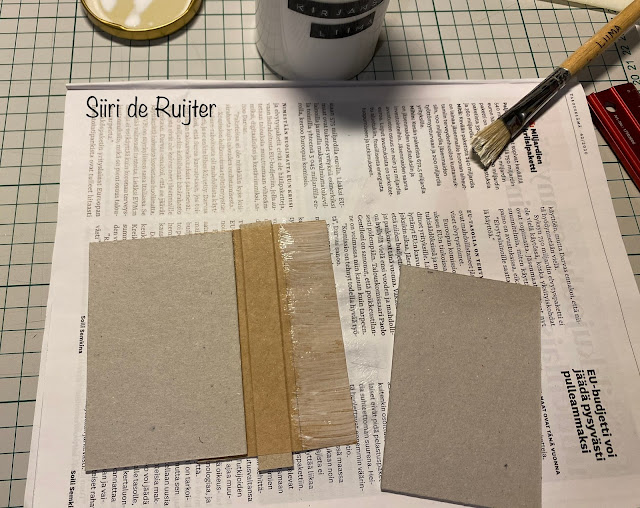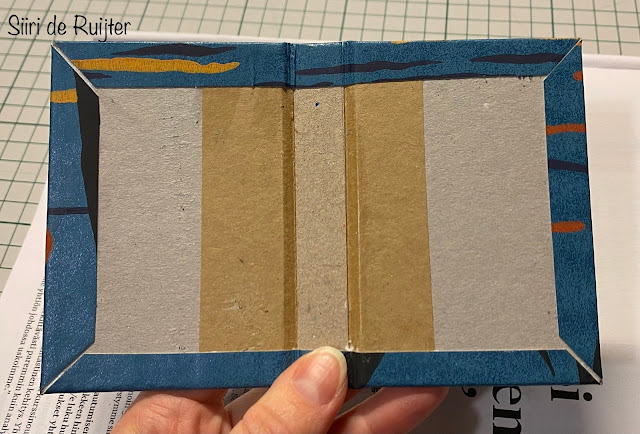Nämä ohjeet löytyvät suomeksi täältä.
I made myself another mini art journal that is the size of an ATC because the first journal (this one) is filled up already. This small size is currently my favorite. You can make a nice mini page in just 15 minutes and even this short moment of art therapy will help. I originally made a book this size because I find the ATC size very inspiring, and I don't always want to make a card that I would exchange when I already have several cards in stock. And sometimes I just want to keep something, too.
I have been asked several times how I made my own journals and decided to make these instructions. I learned the traditional bookbinding in a course, but the pages in it are too close for my own art journaling. That’s why I made this “looser” binding. I love making my own books and every now and then I try new techniques. I have done many of my books as shown here, also the bigger ones. With the bigger ones I often use old book covers. I like old book covers and as a bonus I get the art journal completed much faster. The cover can be further decorated afterwards if desired.
This is how I make my journals. I find this is quite a simple way to make and art journal. I try to measure as little as possible and I don't take it too seriously if something isn't quite right.
There are as many other ways as there are makers. I hope you find your own technique.
Materials:
- papers (for the journal pages)
- paper cutter or similar
- bone folder or similar
- ruler
- pen(cil)
- thick cardboard (for the cover)
- thinner cardboard (for the book spine)
- strong kraft paper (for the cover)
- paper knife or similar
- book binding glue or similar
- paint brush for glueing
- scissors
- paper or fabric for the cover
- bookbinding awl or similar
- cutting board
- (clips)
- bookbinding yarn or similar
- needle
Step 1: Pages
Start by collecting the right amount of paper for you. In this book, I used wallpaper, an old office folder, and a photo album page. I choose pages that are a bit thicker than the normal copy paper, but not quite the 200 g of watercolor paper. Use whatever you prefer - it's your book.
I use mainly recycled paper as pages because
- it's almost always free
- and therefore there is no pressure to use it for my own art
- the paper already has a history of its own (whether it has been found in the professor's old office, in the pile on the floor of an abandoned room after the office moved, from the recycling center ...)
Step 2
Cut pieces of paper of suitable size f. ex. with a paper cutter. For this ATC book, I cut 8.9 * 12.8 cm pieces. The papers inside the journal don’t have to be the same size and can be very inspiring to use different sized pages (as I sometimes do, here).
Step 3
Fold the papers in half. I used a bone folder, but you can also use a knife or similar.
Step 4
Divide the pages into signatures. I have three signatures (booklets) and each has four folded papers.
Step 5
Cut and fold one extra sheet of paper for helping in making holes. I often use an old magazine for this.
Step 6
Mark the locations for the holes on the extra paper. This can be done either by measuring with a ruler or by folding. I fold the extra paper first into half. For such a small book, three holes for each signature is enough. I folded the outer edges a little inward (about 1 to 1.5 cm from the edge).
Step 7
Open the paper and mark the locations for the holes.
Step 8: Cover
Cut two pieces of 6.4 * 9.5 cm from thick cardboard. I cut my own from 2 mm cardboard with a ruler and a carpet knife / paper knife.
Step 9
Cut a piece of 1.4 * approx. 11 cm piece from thinner cardboard (eg. cereal package cardboard). This is the back of the book and will be shortened later.
Step 10
Cut a piece of strong kraft paper about 6 * 11 cm in size (this will be adjusted in the end). Some other paper is also suitable for this, as long as it does not tear easily. Now you have two thick pieces for the cover, one thin piece for the back of the book, and a piece of kraft paper.
Step 11
Glue the thin piece cut in the previous step to the kraft paper with bookbinding glue. You can also use eg. a more liquid gel medium.
Next, the book covers are glued. First, turn the kraft paper around so that the cardboard piece is below. Measure and mark a line 5 mm away from the cardboard piece. Do this on both sides. Put glue until the line and attach the book cover. Turn this over and make sure (for example, with a bone folder) that the paper is firmly attached to the cover without wrinkles. Glue the other side the same way. You can use a ruler (picture below) to help to get the cover to the right position.
Cut a piece of fabric or paper that is much larger than the cover that you want to use for the book cover. The paper should not be too thick so it will fold well over the edges and not too thin so it won't tear when gluing. Fabric works well, I used fabric on my previous book. Now I used a piece of wallpaper. Apply glue to the cover (make sure you have the cover facing the right way) and attach your paper/fabric. Make sure that the cover paper is glued nicely. Again, you can use the bone folder. Make sure to press the paper properly on the back of the book.
Step 15
Once the outside of the book is glued, cut off the extra paper (about 1.5 cm is enough for the overhang) and a piece from each edge. Do not cut too close to the corner of the cardboard, but consider the thickness of the cardboard.
Step 16
Glue the paper on the inside of the cover. Again, use the bone folder to make sure the paper is properly attached.
Step 17
You can cover the cardboard on the inside with a nice paper. Cut the paper to a suitable size. The height is the same as the pages (8.9 cm) and the width should be about 3 cm to cover enough.
Step 18
Cut two pieces of paper of the size 6,4 * 8,9 cm from another nice paper (or in my case here, wallpaper).
Step 19
Decide which way you want the paper and the inner cover papers. I wanted to keep the torn edges visible.
Now you have your cover and the signatures as well as the extra paper.
Step 21
I have four papers in one signature. At this point, check that the order of the papers is to your liking. Now it can still be changed.
Step 22: Binding the book
Use the extra paper to help making holes on the cover. If you want, you can mark the locations of the holes first before making the holes with a bookbinding awl. You can also use another type of punch or sharp tool (eg. nails and a hammer). I have a some fabric as a cushion and a cutting board underneath. Make three rows of holes: one row for each signature.
Step 23
Next, the signatures get holes. Again, use the extra paper for this. Attach it to the signature with clips, if you want, so that it does not move while making the holes. The four-page signature can be pierced at once with the awl. Thicker ones should be separated first.
Step 24
Next, the signatures are bound to the cover. I use bookbinding thread and a larger needle. Another type of thread (eg. embroidery thread) is also suitable for this, as long as it does not rip easily.
Step 25
This is how I bind my books (there are several ways to bind a book). This way, the knot is inside. Be sure to leave the thread long enough to make the knot in the end. You can keep the clips on the signature during binding, but be sure to remove the extra paper first.
Step 26
Tie a knot inside the signature. It’s good to use a friend's finger to help making the knot tight. Cut the excess thread. Repeat the binding for the other two signatures.
Step 27
Your book is ready!
Extra step
I (always) make too many papers. Now I made them into a thin one-signature mini art journal. I cut a cover out of a nice paper that is a little bigger than the inside papers and tied it in the same way as the signatures to the cover of the book. This is an even easier way to make an art journal!
I hope these instructions were useful for you. Please feel free to ask if something was unclear. I'll gladly help. Book binding is awesome and addictive! :D









































Ei kommentteja:
Lähetä kommentti